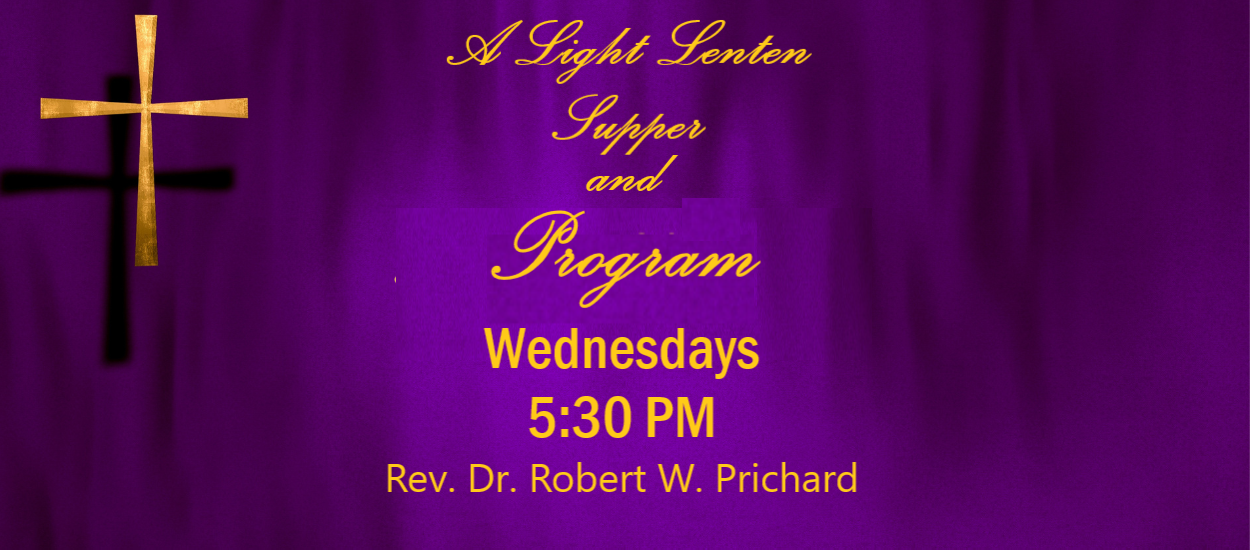Light Lenten Dinner and Progrm
Hosted by the Fellowship Committee
Wednesday, March 12, 20255:30 PM
Christ Church Parish Hall
56 Christchurch Lane Chapel
Saluda, VA 23149
› Driving Directions
 During the first five weeks of Lent, the Rev. Dr. Robert W. Prichard, our priest associate, will be offering reflections on the Book of Common Prayer (1979) following the weekly Lenten dinners on Wednesdays at 5:30 P M. In each session, Bob will look back on the 16th century editions of the Book of Common Prayer (1549, 1552, 1559) that provided the basis for a continuing prayer book tradition and reflect on the ways in which the current prayer book edition of 1979 reshaped that tradition. Bob, who served as the secretary of the Joint Committee on Prayer Book, Liturgy, and Music at the Episcopal Church’s General Conventions of 2015 and 2018, will also share his thoughts on the ways in which the prayer book is being supplemented and revised in the 21st century.
During the first five weeks of Lent, the Rev. Dr. Robert W. Prichard, our priest associate, will be offering reflections on the Book of Common Prayer (1979) following the weekly Lenten dinners on Wednesdays at 5:30 P M. In each session, Bob will look back on the 16th century editions of the Book of Common Prayer (1549, 1552, 1559) that provided the basis for a continuing prayer book tradition and reflect on the ways in which the current prayer book edition of 1979 reshaped that tradition. Bob, who served as the secretary of the Joint Committee on Prayer Book, Liturgy, and Music at the Episcopal Church’s General Conventions of 2015 and 2018, will also share his thoughts on the ways in which the prayer book is being supplemented and revised in the 21st century.
Please join us for the Lenten dinner and for the education presentation that will follow. Individual topics will include:
- March 12. The creation of a single book. Prior to the mid-16th century, the materials needed for regular worship were divided into multiple specialized volumes, which were too expensive for ordinary church members. In 1549, the leaders of the English Reformation brought all this material together in a single volume that contained everything needed for regular worship—a Book of Common Prayer. The advent of on-line publishing in the late 20th century has led some Episcopalians to re-think this idea of a single comprehensive volume.
- March 19. The Baptizing Community. While baptism has been a regular element in the life of the followers of Jesus since the first century, the manner in which it has been administered and the relationship to a sometimes separable office of confirmation have varied greatly over time. The editors of the 1979 Book of Common Prayer recast the Baptismal office in ways that we are only beginning to understand.
- March 26. The Holy Eucharist. The service of Holy Communion included in the first Book of Common Prayer of 1549 was a conservative editing and translation into English of materials from the late Medieval Roman Catholic liturgy. Three years later, the second prayer book (1552) followed a path more in line with the Reformed Church of Switzerland and the thinking of John Calvin. It has been argued that the multiple editions of the Book of Common Prayer since 1552 have wrestled with finding a balance between these two approaches to the celebration of the Eucharist. The 1979 edition continues this process but also reflects new insights from the 20th century Liturgical Movement.
- April 2. The Daily Office and the Lectionary. Prior to the Reformation, most lay persons had no exposure to the Daily Office in their local parishes, though they could witness the service by visiting monastic institutions. The first prayer book created a simplified daily office that involved two services (Morning and Evening Prayer) rather than the eight services celebrated by monks and nuns. The prayer book directed that all clergy read the services in church daily and prescribed a lectionary that directed reading of the entire Psalter each month and of most of the rest of the Bible each year. American Episcopalians changed the expectation of that frequency after the American Revolution and, for a century following the Civil War, read Morning Prayer chiefly as a Sunday service that alternated with the Eucharist. The 1979 prayer book attempted to restore the Daily Office as a weekday service, reserving Sunday for celebrations of the Eucharist. Some in the 21st century are rethinking that change in the light of declining church membership.
- April 9. Confession. The vision of the editors of the first Book of Common Prayer of 1549 stepped back from the late medieval understanding of sin and repentance as a pastoral matter to be handled in private with a priest. The first prayer book followed a different path, adding confession and absolution to the regular public services of the church. They eliminated the expectation that private confession was needed for reception of the Eucharist, though they allowed for private confession as an option for those with a troubled conscience and those facing death. They did not, however, provide any liturgical form for it. The 1979 prayer book is the first American Prayer Book to reintroduced a set rite for private confession. In the past three decades, the Episcopal Church has offered supplemental materials intended to expand our understanding of that for which we should seek forgiveness.




